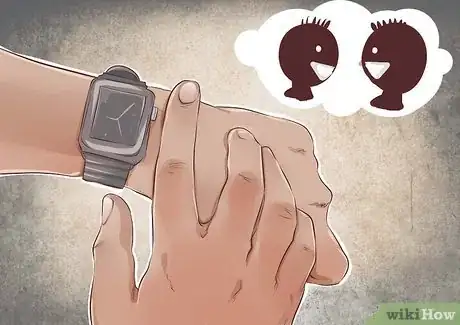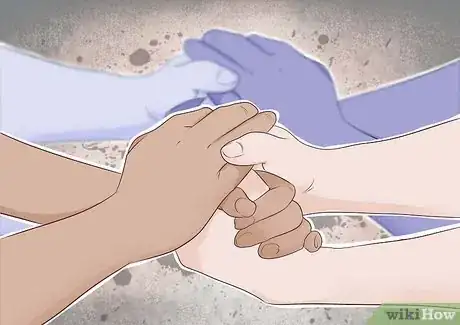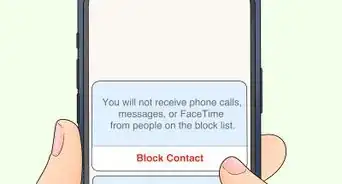This article was co-authored by Katie Styzek. Katie Styzek is a Professional School Counselor for Chicago Public Schools. Katie earned a BS in Elementary Education with a Concentration in Mathematics from the University of Illinois at Urbana-Champaign. She served as a middle school mathematics, science, and social studies teacher for three years prior to becoming a counselor. She holds a Master of Education (M.Ed.) in School Counseling from DePaul University and an MA in Educational Leadership from Northeastern Illinois University. Katie holds an Illinois School Counselor Endorsement License (Type 73 Service Personnel), an Illinois Principal License (formerly Type 75), and an Illinois Elementary Education Teaching License (Type 03, K – 9). She is also Nationally Board Certified in School Counseling from the National Board for Professional Teaching Standards.
There are 10 references cited in this article, which can be found at the bottom of the page.
This article has been viewed 74,062 times.
Having a trustworthy circle of friends is important to most people. However, there may come a time when you feel that one of your most beloved friends has stabbed you in the back. When this happens, it can be difficult to forgive and trust that person again. Fortunately, there are ways to move through even the worst betrayal to salvage your friendship.
Steps
Letting Go of the Anger
-
1Accept that the situation has happened. Avoid wishing that your friend had behaved in a different way. Allowing yourself to constantly think things like, “Wow, I can't believe that she did that” will only increase the resentment.
- Ruminating over your friend's actions will only make you feel worse. Make the decision to accept what has happened so that you can move on.
-
2Use affirmations to help release the anger. Try reprogramming your negative thoughts toward this person by saying affirmations out loud as often as possible. Keep saying them until the anger begins to lessen.
- Affirmations will help you tell yourself a different story You want to use your words to create a different mindset. The affirmations can be as simple as saying, “I forgive Amy for spreading rumors about me.”
Advertisement -
3Focus on intentionally feeling good. Remind yourself that the anger is actually hurting you more than the other person because it's impacting your emotional and perhaps even physical health. Then intentionally choose to focus on something that feels better. Notice that the bad feelings are not helping you but are actually making you feel worse.
- Gratitude can also help to reduce overall anger. When you feel yourself starting to get angry about the betrayal, choose instead to make a list of all of the things that you have to be grateful for.
-
4Release the tension in your body. When you are angry, your body automatically goes into fight-or-flight mode.[1] However, because your mind and body are connected, when you allow your physical body to relax you can think more clearly and release anger. Deep breathing is an effective and reliable way to quickly go into a relaxed state. Here's how to do it:
- Sit in a chair with your spine straight. You'll probably be most comfortable with the back of the chair supporting your back. You can also lie down straight on a flat comfortable surface.
- Close your eyes and put one hand on your stomach and the other on your chest.
- Take a slow deep breath. Feel the breath start in your diaphragm and work its way up to your head. You should see the hand on your chest raise.
- Then slowly exhale. The hand on your stomach should raise as the air moves out.
- Repeat this process for five minutes to seven minutes or until you feel calmer.
-
5Think about what you have learned from the experience. Remind yourself that every situation is an opportunity to learn and grow. When you're able to see the silver lining, then it's easier to release the anger and forgive.[2]
- Remind yourself that you can either be bitter about the situation or you can find an opportunity to grow from the experience. Ask yourself the question, “What have I learned from this experience?” Then take a few minutes to explore what comes to mind. For example, did you learn to be more selective about what you share with others?
Resolving the Conflict
-
1Prepare to have a conversation with your friend. Good communication is important in order to resolve any type of conflict. Therefore, it's important to know exactly what it is that you want to discuss. Before beginning any conversation, reflect on what it is that is bothering you and what you want to get from the conversation. Try asking yourself these questions:[3]
- “What do I want to get from this conversation?”
- “What exactly is bothering me?”
- “What do I want the other person to do or not to do?”
- “What are my goals for this conversation?”
-
2Set a time for the conversation. Try to set a time to meet as soon as possible but make sure that the time is convenient for both of you.[4] Setting a specific time to talk rather than springing it on her without warning is important. If she isn't expecting it, then she may feel that she is being attacked which means that conversation will not go very well.
-
3State the problem calmly and clearly. Start the conversation by sharing with your friend the facts of the situation. Only after you have finished sharing the facts should you share how you feel about what happened.[5]
- For example, you could start by stating the facts, “I was told that you shared a personal secret about me to Maria.”
- Then you could share how you feel by saying, “I am very upset and feel betrayed.”
- Be sure to stick to “I” statements rather than “You” statements. For example, you should say “I feel upset and betrayed” instead of saying, “You betrayed me.”
-
4Allow the other person to speak. This conversation should be focused on finding a resolution to the problem. This means that both of you should have the opportunity to speak. Listen to your friend without interrupting and try to hear her perspective.
- For example, you could ask your friend, "How do you see the situation?" or "What do you think about what happened?"
- Then allow your friend to speak without interrupting her. Try really hard to focus on what she is saying and not what is running through your own mind.
-
5Suggest solutions to resolve the problem. Tell your friend what you think needs to happen in order to salvage the friendship.[6] Also, be open to hearing what your friend has to say. This is the time to set boundaries to make sure that the situation does not recur. Also, do not be afraid to ask for an apology if you think that you deserve it.
- Be sure to explain why you are making the suggestions and how that would benefit your friendship. For example, you could say, “From now on, let's agree to not discuss what we have shared with each other with other friends unless we have received permission from the other person.”
- Your friend may decide that she does not want to offer an apology. Be prepared to accept her decision if that happens. If she refuses to apologize, you will need to decide if you want to continue to reconcile the friendship.
-
6Celebrate the solutions. Once you have finished the conversation and things are amicable again, celebrate the success of the meeting.[7] Remember, the goal is not to win, the goal is to resolve the conflict.
- If things have not been resolved then schedule another time to revisit the conversation. Alternatively, you could decide that reconciliation may not be the best option right now.
-
7Make new friends. If your friend continues to act in a hurtful manner toward you even after you've tried to resolve the conflict, then it's probably time to make new friends. You deserve to be respected and treated well. Therefore, if the conflict goes on for an extended period of time or if you find that your friend keeps doing the same thing over and over again, then it's time to start looking for new people to spend your time with.[8] Here are some great places to meet new friends:
- Extracurricular activities
- Hobbies
- Work
- Church
- Classes
- Online forums
- You should not go to meet anyone in person that you don't know unless you are not an adult or accompanied by a Guardian. Also, be sure to go during the day to a pace where there are plenty of people.
-
8Seek help when necessary. Sometimes resolving the conflict with your friend can be harder than you thought it would be. When this happens, it could easily escalate into a situation of bullying.[9] Be sure to know the signs of bullying so that you can seek help from a trusted adult if you feel that you are being bullied. Here's what bullying looks like:[10]
- Physical or verbal aggression that happens repeatedly or has the potential to happen repeatedly
- Making threats offline or on social media
- Spreading rumors offline or on social media
- Purposely excluding you from the group
Forgiving Your Friend
-
1Think about the benefits of forgiveness. It can be very hard to forgive someone who has stabbed you in the back. However, there are many emotional and physical benefits that occur when you forgive someone who has wronged you. When you are consciously aware that your own well-being will actually improve when you forgive your friend, you may be more motivated to do so. Here are some of the benefits of forgiving others: [11]
- Decreased depression and lessened anxiety
- Greater overall psychological well-being
- Reduced levels of stress
- Greater spiritual connection
- Strengthened immune system
- Lower blood pressure and improved heart health
- Better interpersonal relationships
- Increased self-esteem
-
2View the situation from the other person's perspective. Sometimes unintentional betrayal happens because of a misunderstanding. Therefore, it's important to consider the other person's perspective. Taking time to reflect on the intention behind the behavior can really help you begin the process of forgiving her.
-
3Focus on compassion. Showing compassion when someone betrays you is difficult but it is essential to the forgiveness process. The most effective way to demonstrate compassion is to consider how the other person may actually be feeling right now and try to empathize. However, there are multiple ways that you can cultivate greater compassion:[12]
- Remind yourself that everyone is ultimately doing the best that they can. It's helpful to keep in mind that everyone misses the mark sometimes. Think back to a time when you may have unintentionally betrayed a friend. For instance, have you ever believed gossip about a friend or talked about your friend to someone else?
- See the individual as a person and not as “the person who stabbed you in the back.” When you see her as a person who has flaws and sometimes makes mistakes, you may be more willing to forgive her.
- Look for things that you have in common with the person. Do you have similar hobbies or do you have the same parenting style? When you see yourself as being similar to a person, you tend to have more compassion for her.
- If you're spiritual, it may be helpful to rely on the religious teachings of unity and grace.
-
4Make the decision to forgive. Forgiveness is making a shift in your thinking so that you no longer have the desire to seek revenge or ill will toward the person that you feel has wronged you.[13] Keep in mind that forgiving a person is not the same thing as condoning their actions. Forgiveness is the conscious decision to release your negative thoughts toward the other person so that your own well-being can improve. Remember, you can forgive and still take action to protect yourself from future betrayal.
-
5Let go of the grudge. Decide whether you want to tell the person directly that you have forgiven her or whether you'd prefer to privately release the grudge.[14] Your decision will probably depend on the specifics of the situations and your own individual comfort level. Here are ways that you can let go of the grudge publicly or privately:
- Call the person up or ask to meet with her in person. Tell her directly that you forgive her. You can say something like, “I was upset that you said those things behind my back. However, I have decided to forgive you and not let that impact out friendship.”
- If you decide to release the grudge in private, you can simply say out loud to yourself, “I forgive Kim for hurting me.” Say as much as you feel compelled to say about the situation. You could also write a letter and then discard it. The point is to give yourself the opportunity to actually release the grudge, even if it is in private.
-
6Establish new boundaries.[15] Boundaries will help you rebuild a sense of safety with your friend. They can really help to prevent similar situations from reoccurring again. The boundaries may adjust again as time elapses, but in the beginning it is a very important component of rebuilding trust.
- For example, let's say that you found out that your best friend was gossiping about you. One of the boundaries that you might implement is to limit the amount of time that you spend around her for a while; until the trust is rebuilt.
References
- ↑ http://msue.anr.msu.edu/news/forgiving_and_letting_go_tough_to_do_but_the_benefits_are_many
- ↑ http://greatergood.berkeley.edu/topic/forgiveness/definition
- ↑ http://cmhc.utexas.edu/fightingfair.html
- ↑ http://cmhc.utexas.edu/fightingfair.html
- ↑ http://cmhc.utexas.edu/fightingfair.html
- ↑ http://cmhc.utexas.edu/fightingfair.html
- ↑ http://cmhc.utexas.edu/fightingfair.html
- ↑ Katie Styzek. Professional School Counselor. Expert Interview. 28 October 2020.
- ↑ Katie Styzek. Professional School Counselor. Expert Interview. 28 October 2020.
- ↑ http://www.stopbullying.gov/what-is-bullying/
- ↑ http://www.mayoclinic.org/healthy-lifestyle/adult-health/in-depth/forgiveness/art-20047692
- ↑ http://greatergood.berkeley.edu/topic/compassion/definition
- ↑ http://www.pbs.org/thisemotionallife/topic/forgiveness/understanding-forgiveness
- ↑ https://www.psychologytoday.com/blog/mindful-anger/201409/how-do-you-forgive-even-when-it-feels-impossible
- ↑ https://www.psychologytoday.com/blog/in-therapy/200909/four-elements-forgiveness














































































